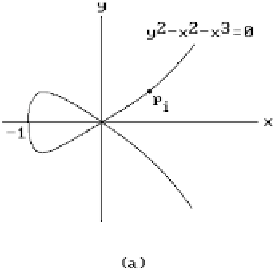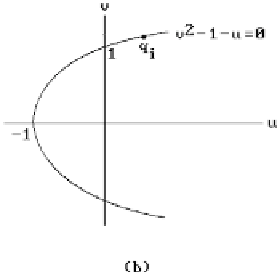Graphics Reference
In-Depth Information
Removing the singularity of f(x,y)
=
y
2
-
x
2
-
x
3
.
Figure 14.24.
-
1
-
1
T
:
x
=
u
and
T
:
x
=
uv
1
2
(14.14)
yuv
=
yv
=
.
Also, property (3) of T
1
is simply a consequence of the fact that, except for the origin,
the points of the line y = mx gets mapped by T
1
to the line v = m.
To remove the singularity of f(x,y) = y
2
- x
2
- x
3
.
14.5.1.2
Example.
Solution.
See Figure 14.24. The map T
1
transforms f(x,y) into g(u,v) = u
2
(v
2
- 1 - u).
This means that the points of the curve
C
defined by f(x,y) = 0 that have nonzero x-
coordinates get mapped into the curve defined by v
2
- 1 - u = 0. To see what happens
to the branches of the curve at the origin, let us solve the equation f(x,y) = 0 for y. We
get
yx x
=±
1.
This shows that one branch at the origin of our curve
C
satisfies equation f
1
(x,y) = 0,
where
(
)
=-
fxy
,
y x
1
+
x
.
1
Applying T
1
to f
1
(x,y) gives
(
)
(
)
=-+
guv
,
uv
1
u
.
1
From this it is easy to see that if
p
i
are points on the branch of
C
defined by f
1
(x,y)
that converge to the origin, then the points
q
i
= T
1
(
p
i
) converge to (0,1). In other words,
the origin that was a singular point for f(x,y) has been resolved into the nonsingular
point (0,1) for g(u,v). Finally, note that at the origin, the tangent line of the curve
defined by f
1
(x,y) has slope 1 and the line y = x gets mapped to the line v = 1.
Let us return to our curve tracing. Suppose that we are at point
p
on the curve
C
and
we are approaching a singularity at the origin. What we have to do is the following:





